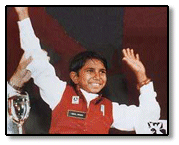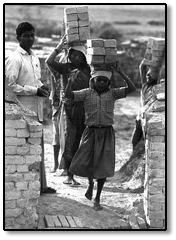|
Student activist tries to end child labour
By Katie Norman
I.J. Samson Junior High
St. John's, Newfoundland |
|
Imagine that you are three years old. Your parents are drowning
in debt, their only chance of survival is to sell you to a carpet
factory. There, you will work for three cents a day for twenty
hours a day. When your work is over, you can give your money
to your owner to help with your debt or you can use the money
to buy yourself some rice to eat.
To many children, this is a fact of life. |
|
Alicia Lauersen, president of the Fort McMurray chapter of
Free the Children,
recently visited I.J. Samson Junior High in St. John's, Newfoundland
and talked to the students about child labor. The truth shocked
us all.
Lauersen became involved in protesting child labor and promoting
the rights of children two years ago, when she was only twelve.
She found out about this problem when her chaperone Lyn Gorman
attended a conference with Craig
Kielburger, a teenager who led the fight against child labour. |

Craig Kielburger |
|
Gorman was so moved by his words and insight into this horrible
problem, that she took a video back to her school. She felt that
there was a need to have more children follow in Craig's footsteps
so she showed all the students at her school from Grades 5 to
8. Because the students showed such interest in the issue, Gorman
held a mini-conference a few days later. Lauersen asked if she
could somehow help.
That was how it all started and it has snowballed since then.
A group of students in Fort McMurray, Alberta have helped to
get a by-law passed, making it illegal to sell soccer balls and
fireworks in their town that have been made by children.
This group of kids have been recognized all over the world.
They have sent letters to Nike trying to get them to stop using
child labor. Their efforts helped and Nike signed an agreement
to stop using child labor. They have also sent letters to help
change the conditions for children in Bangladesh.
Lauersen told the students at I. J. Samson that children work
as carpet makers, and clothing makers. They not only produce
goods, but sometimes they are soldiers in wars. They do this
because it is cheaper to have children on the battle ground than
adults.
Child labor is a vicious cycle, a curse that passes from generation
to generation. Many children work for the same companies as their
grandparents and they have to continue to pay off the family
debt to the company. When children begin to work in a factory,
they often are already in debt and must work to pay it off. If
a product is not perfect, the debt increases and so do the generations
of that family who will have to be child laborers. The children
are often beaten or blinded or branded by hot iron stamps to
show ownership to that company. |

Iqbal Masih |
Our only information of child labor comes from insiders, people
willing to risk their lives to let the world know about this
problem. One child, Iqbal
Masih, escaped from a factory and told his story to the world.
He spoke about his life as a child laborer, more like a child
slave. He delivered an emotional speech to the members of the
United Nations. A little while later, he was shot, and killed,
near his home in Pakistan. No one knows who killed him, but people
suspect the carpet Mafia. |
|
Child labor exists all over the world, not just in Asia. In
countries like India, as many as five million children are child
laborers. The country that shocked me was the United States of
America, with 300,000 children working as child laborers.
Many people think they don't buy products of child labor.
But companies such as Mattel, Fisher Price, Nike, Adidas, Reebok
and clothes from the GAP, are all sub-contracted to factories
that may use child labor. It is not necessarily all the products;
it depends on what factory it came from.
Child labor makes poor countries remain poor. The children
and future leaders of the country are forced to work in factories.
This doesn't allow the children enough time or money to attend
school, so when they all grow up they are another population
of uneducated adults to be taken advantage of by the rich. In
a system like this, the rich get richer and the poor get poorer. |
|
Alicia Lauersen gave us insight into all these problems. She
let us know that the only way we can change this is to take matters
into our hands. She and her group have. Whether they're writing
letters to Ralph Klein to get him to sign the United Nations
Convention on the Rights of the Child or raising money for Free
the Children, they are doing their part, and you can do something
about it too.
For more information about child labour, visit UNICEF's
site for a list of related link under the Child Labour and Children
at Work sections.
|

In Nepal, children and women carry bricks
on their heads. They earn $0.25 for every 100 trips. UNICEF/93-1257/
Noorani |
|